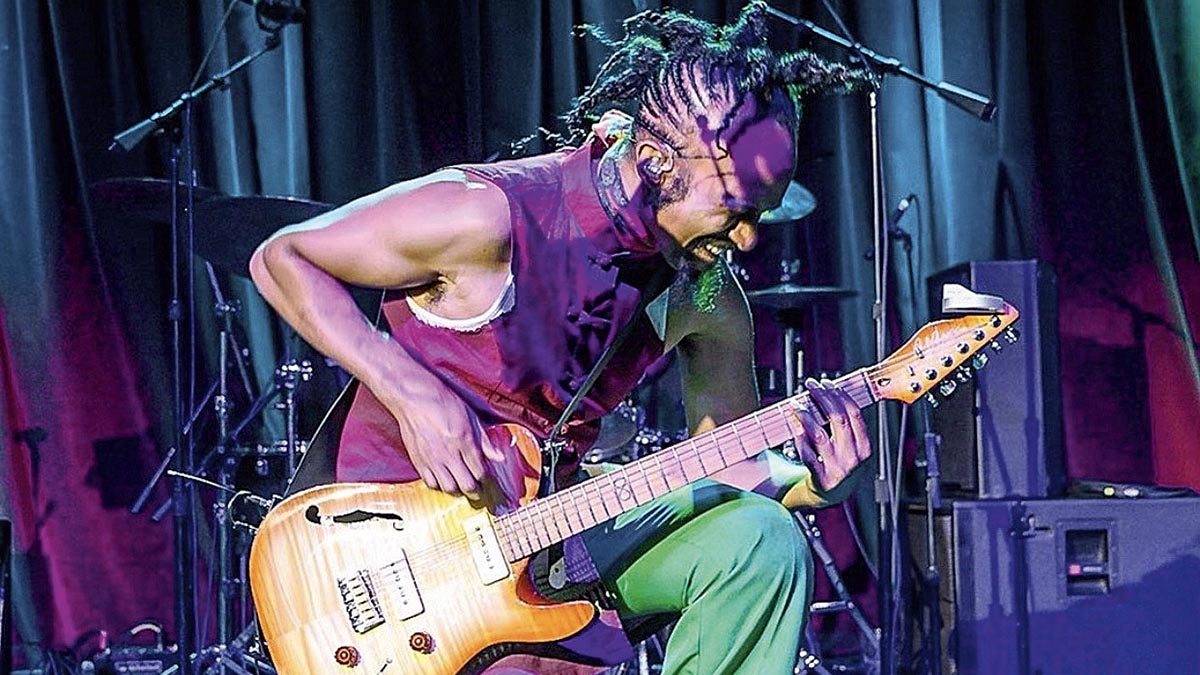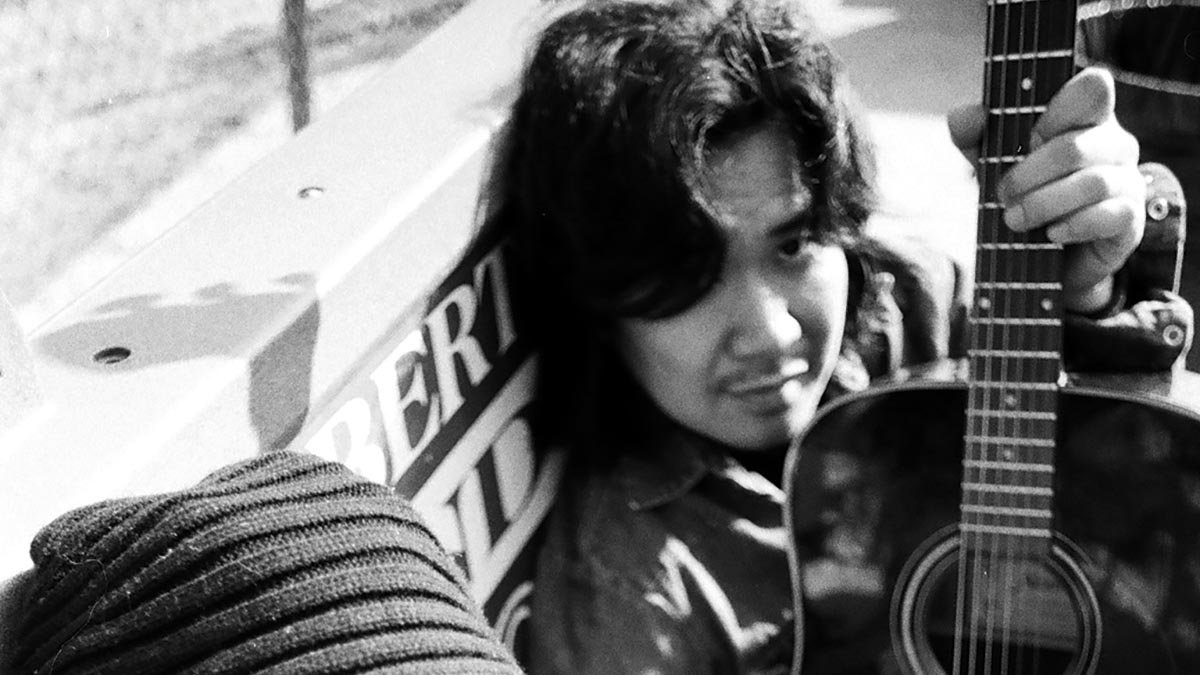Fantastic Negrito on the near-fatal car crash that changed his approach to playing and the forces behind his powerful new album, White Jesus Black Problems
The Grammy-winning songwriter discusses the quirks of his unique strumming technique, his historic punk rock heritage and how Masa Kohama became the perfect foil for his unorthodox style

First discovered by many when his explosive NPR Tiny Desk Concert aired on YouTube back in 2015, Xavier Amin Dphrepaulezz – or Fantastic Negrito, as you’ll more likely know him – has one of the most incredible and unique musical life stories imaginable.
Indeed fantastical at times, and calamitous at others, it would probably be deemed too implausible by even the most fanciful of Hollywood movie directors – if it weren’t entirely true, that is.
After growing up in an Orthodox Muslim household in Massachusetts, Negrito's cultural horizons exploded into full technicolor when he relocated to California in the 1980s, settling in “beautiful, grimy old west Oakland”, as he calls it.
He learned to play and write music on multiple instruments by infiltrating classes at the University of California Berkeley, and by 1993, had landed himself a million dollar deal with Interscope Records. Around this time, he met Masa Kohama – a Japanese self-taught guitarist who was living and working in L.A. at the time, and they began making music together.
Then, in 1999, Negrito was involved in a near-fatal car accident, which left him in a coma for three weeks, and robbed him of almost all mobility in his right hand and wrist. His future as a musician seemed doomed.
“I remember waking up from the coma,” he says. “It was three weeks – I had a full beard, long fingernails, I weighed about a hundred pounds – and I remember, in my weak voice, I said, ‘Are my hands okay?’ and the nurse didn’t say yes or no, she just shook her head. It was the first thing that I thought of.”
In the wake of this catastrophic accident, Interscope dropped him from the label, and only after intense physical therapy was he able to begin playing music again – this time, to an audience of passersby on the subway, and for the first time, under the name of Fantastic Negrito.
Get The Pick Newsletter
All the latest guitar news, interviews, lessons, reviews, deals and more, direct to your inbox!
“I was an old guy when I decided to do this,” he says. “I thought: ‘No one cares about what I’m doing, I’m just going to play on the street’. I literally had no idea that I’d go on to become an artist, I just didn’t care. I think there’s something very powerful about not caring.”
It was a long road from there – it took him until 2014 to get his first album out – but since then his profile has risen fast. He has won three Grammys, and now he is embarking on his most ambitious project to date – something that began during the pandemic, when he decided to look into his family lineage using an online ancestry tool.
“I just got a little bit curious and I went down the rabbit hole – you know how that happens on the internet.” What he discovered was mind blowing: “On day two of looking into my ancestry, I find out my name’s not real, my Dad was a complete liar. On my mother’s side, they came from free black folks in Virginia who came from a forbidden union of a Scottish white indentured servant and an enslaved, black African man seven generations ago.”
Inspired by this discovery, Negrito set about chronicling the lives of his rebellious relatives, Elizabeth Gallimore and “Grandpa Courage,” in the form of an album and accompanying film, both of which are titled White Jesus Black Problems. As Negrito himself puts it: “These were my relatives. That’s some punk rock shit. I thought it explained who I was. I thought that all my life, this is why I’ve felt the way I’ve felt. So the album had to match that audacity.”
In a blend of delta blues and country music, funk, soul and rock, seemingly disparate genres come together on White Jesus Black Problems with spectacular effect and assertiveness. “It’s funny,” he explains, “all of those things came from American people in the 1700s.”
Guitar duties were divided between Negrito and his long-time friend and collaborator Masa Kohama, whose tasty and tasteful lead playing is all over the record.
Like many of us, Kohama grew up on a sonic diet of British Invasion bands like The Beatles, The Rolling Stones and Led Zeppelin, before maturing tastes led him towards jazz greats like Wes Montgomery and Joe Pass. He can play, it seems, just about anything.
Reflecting on how his thirty year musical partnership with Negrito now works, Kohama explains, “He doesn’t tell me that much about what he wants, but I can pretty much feel it because we’ve been doing this together for such a long time. Most of my parts on the record are just freestyle and improvised, and he ends up picking from the parts I’ve played.”
Although most artists have recently had to adjust to remote ways of working due to Covid-19, the pair have been doing it this way for years as Masa resides in Tokyo and Xavier in California.
But the distance between them has some surprising advantages. Says Kohama: “I feel it’s more comfortable doing it that way. Sometimes when he’s standing right next to me when I’m recording, he talks too much and I get distracted. So it’s better that I do my thing and he picks out what he likes.”
Beneath this pick 'n' mix approach to the record’s lead guitar parts lies the constant pulse of what Negrito describes as “my very clumsy rhythm”. Through necessity and sheer determination since his accident, he’s developed a unique strumming technique, which relies less on small movements in the hand and wrist and more on larger movements of the whole right arm, with the thumb, he says, “acting kind of like this hammer”.
“I do all these weird rhythm parts that give the album its feel and its personality,” he explains. “The engineer always says, ‘Man, if we don’t have your really bad guitar, there’s something missing!’ It’s that really ugly hacking that I do. I’m probably exaggerating, but I think there’s something very unique about what I bring to all the records.”
Typically, Negrito will also sample Kohama's improvised rhythm parts and blend them with his own to create something that he describes as both “proper” and “rugged”.
My thumb just doesn’t move. It won’t move and I just gotta accept it. My hands feel like someone poured concrete in them
Fantastic Negrito
Explaining the physical and mental hurdles his injuries posed, he reflects, “It took a lot of time to get to the place where I could accept what I could and couldn’t do. My thumb just doesn’t move. It won’t move and I just gotta accept it. My hands feel like someone poured concrete in them. They have no fluidity, so just accepting things sometimes is very powerful.”
Ruminating on his own experiences in relation to those of his ancestors told by the album’s narrative, he adds, “It turns out that I came from generations of people like that and I just never knew.”
Beyond rhythm, Negrito also laid down some lead parts on the record, including those on its heaviest track, Man With No Name – which he describes as “James Brown meets Black Sabbath.”
Humorously, he suggests that, for anyone trying to distinguish between his and Kohama’s lead playing, the tell tale sign is: “Anything weird, that’s me!” Dynamically, this track is also interesting, and particularly interesting point comes when the funky verse groove shifts into the much heavier Sabbath-esque chorus. Here, there is a 6bpm shift downwards in tempo, which helps the transition between light and dark moods. “You can’t really hear it,” Xavier says, “but you can feel it.”
Elsewhere on the album, other genres and moods crash together with spectacular narrative-enhancing results. Trudoo, for example, pairs Nashville country blues with funk to create a celebratory ode to freedom, while the album opener Venomous Dogma transitions from dreamy pop to ominous blues rock riffage to convey the contrast of both Grandma Gallimore and Grandpa Courage going from extreme freedom in their respective homelands, to extreme bondage in Virginia.
When it comes to the business of discussing guitars Negrito laughs, “My guitars are usually the ones that other people don’t want! But I have some really great ones as well.” His rags to riches collection spans everything from a beat up $50 guitar he used to busk in the subway shortly after his recovery, to a Gibson Les Paul Gold Top, a semi-hollow Chapman ML3 Pro and a classic Gibson Hummingbird acoustic.
For the album, Kohama also pulled out some interesting choices, including an H.S. Anderson Mad Cat, which you’ll most likely have seen before in the hands of Prince. “It’s kind of like a Tele,” he explains, “I didn’t use this guitar on the last three albums, but I used a lot of the Mad Cat on this one – especially for those country licks and a lot of the funky rhythm stuff.” For much of the bluesy lead work on tracks like Oh Betty, Kohama channels a BB King vibe with a Gibson ES-335.
Elsewhere, he uses his own Schecter Masa Kohama Signature model – a Stratocaster-style guitar with humbuckers in the bridge and neck positions, and a single coil in the middle position.
Kohama was first inspired to try this configuration after seeing New York session legend and sideman to the stars, Hiram Bullock, do so back in the 1980s. He explains, “Nowadays, a lot of people put humbucking pickups in the front on a Strat, but in the '80s, not many people were doing that. Hiram was, and I started doing it too.”
The benefit of this set-up is versatility. He explains, “I can have a fat humbucker jazzy sound, a funky treble-y sound and a heavy rock sound all on the same guitar.” On an album where Negrito tasked Kohama with channeling so many flavors and styles, the Schecter was the perfect tool for the job.
Similarly, on Kohama’s own versatility and ability to keep up with the album’s many creative directions, Negrito remarks: “Whatever lane I go down, he’s like, ‘No problem!’ I’ve never met another guitar player ever that could authentically follow me down any lane that I’ve wanted to go down.”
Live, I use a lot of pedals – I’m a pedal junkie. Negrito hates that. He’s always telling me I don’t need so many
Masa Kohama
The pair have been in everything from punk to R&B bands together over the years, so there’s a long history of putting each other through their paces and breaking new musical ground together.
As for experimenting with pedals and effects on the record, Kohama reveals, “I didn’t use many at all – just a wah and a volume pedal, and maybe just a little booster.” He adds, “Live, I use a lot of pedals – I’m a pedal junkie. Negrito hates that. He’s always telling me I don’t need so many.”

Still, Kohama puts this limited selection to good and tasteful use throughout. A particular highlight is the funky, wah-laden track, Highest Bidder, which sets lyrical themes of human greed and the flaunting of wealth to a delirious soundtrack of blues-meets-disco.
What’s striking about the entire record is that very few normally-adhered-to rules seem to apply. Simultaneously it feels vintage and experimental, its moods are both celebratory and oppressive and there’s simply nothing to be gained from trying to categorize it as any particular genre.
Says Negrito, “I really wanted to smash the walls on this record. As artists, we’re just trying to get to that truth, and it means everything, especially in today’s world.”
Reflecting on the ambitious and highly conceptual nature of the whole project, Negrito explains, “I just reached a time, age and place where I create with the liberty of a 17-year-old, combined with the wisdom of a grandfather. I don’t have the hangups. I’m not trying to be a superstar.”
Throughout the course of the interview, Negrito makes it very clear that the word “limitations” is not in his vocabulary – musically or otherwise. He chooses to focus on what can be done, rather than what can’t.
His next project – an acoustic reworking of the entire record – is already near completion, and the inspiration just keeps coming. “It’s the spectrum of life that I enjoy,” he remarks, “and I just kind of walk towards that – like Grandma Elizabeth Gallimore. It can all be done, you know?”
- White Jesus Black Problems is out now via Storefront Records.
Since graduating university with a degree in English, Ellie has spent the last decade working in a variety of media, marketing and live events roles. As well as being a regular contributor to GuitarWorld.com, she currently heads up the marketing team of a mid-scale venue in the south-west of England. She started dabbling with guitars around the age of seven and has been borderline obsessed ever since. She has a particular fascination with alternate tunings, is forever hunting for the perfect slide for the smaller-handed guitarist, and derives a sadistic pleasure from bothering her drummer mates with a preference for wonky time signatures.
“I pushed myself to down-pick faster and make the riffs more aggressive. Maybe it’s the old man in me struggling to feel young and fighting back against aging”: How Killswitch Engage went to thrash metal bootcamp to deliver their face-ripping return
“I always felt like that record could have been better if we had worked on it some more”: Looking for a blockbuster comeback album, Aerosmith turned to Van Halen producer Ted Templeman. For Joe Perry, it served as a learning experience










